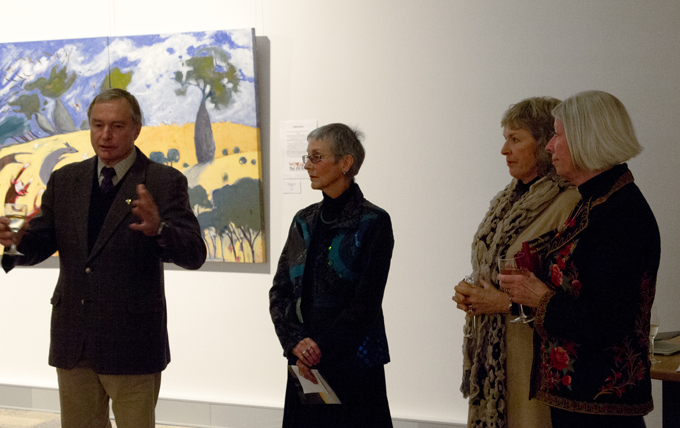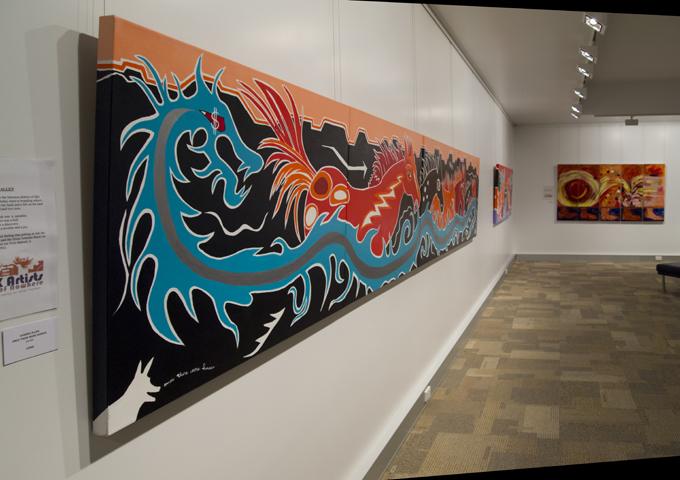SHOOTING STRAIGHT: Regional Artists as Provocateurs
Shoot Straight You Bastards, Bungil Gallery, Roma, Queensland. 6 July-12 August, 2012
.
In her book The Lure of the Local (1997) Lucy R. Lippard states that ‘Artists can be very good at exposing the layers of emotional and aesthetic resonance in our relationships to place.’ (Lippard 1997:286) She also defines an ‘ethic’ for ‘art governed by place’ which includes the expectation, amongst others, that the work should be, ‘Provocative and Critical enough to make people think about the issues beyond the scope of the work, to call into question superficial assumptions about place, its history and its use.’ (Lippard 1997:287)
An exhibition at the Bungil Gallery in Roma, Shoot Straight You Bastards, by artists who collectively call themselves, the 6 artists from out of nowhere, creates a powerful document about relationships to place which are, as Lippard demands, ‘provocative and critical enough to make people think.’ These artists are from the Bowen Basin area around Central Southern Queensland that is currently the centre of a mining boom driven by the world’s need for cheap energy. In the enthusiastic push for profits to bolster shareholder’s returns and to reduce budget deficits, both the mining industry and the government have grasped the opportunity. While it may seem perfectly logical to develop a resource and capitalise upon it, there are many who oppose it. The principle concerns shared by many of these local communities are the threats to the farming and grazing productivity of the land, and the potential risk for long term damage to the quality of underground water across the region where mining and gas extraction is undertaken. The transformative effect on the communities and the landscape should not be underestimated.
The six artists are, Sandra Allen, Anne Cameron, Elizabeth Corfe, Barbara Hancock, Helen and Wally Peart. These artists and their families live on and work within this landscape as farmers and graziers. Time spent creating their artwork has to ‘fit in’ with the demands of daily living and working on the land. In their bios, the artists reference the many challenges of making art on a working farming property, as three of the artists reveal:
Anne Cameron, As with all women on the land, her artistic aspirations had to be subjugated to the needs of the property and the family,
Barbara Hancock, … the urge to paint often saw her running from paint brush to breast feeding the latest baby, and
Elizabeth Corfe’s life, has been shaped by a lifetime immersed in the highs and lows of making a living off the land.
Even though there have been obstacles they remain dedicated to their art and when possible have engaged in art training through a range of opportunities including academic study, Flying Arts and the Roma Art Group. Their works are technically and conceptually strident—quite distinct from the stereotypic pastoral ‘windmill in the sunset’ and ‘gum tree lined billabong’ paintings that art aesthetes may consider regional artists make.
These artists have amassed a large body of work expressing their concern for the land and, what they see as its impending demise. The title for the exhibition, Shoot Straight You Bastards originates from the last words of Breaker Morant as he stood before the firing squad. The six have chosen this phrase as their catch cry and they apply it to their current situation—shoot straight implies that the proponents; mining companies and governments present honest and accurate information and manage this development ethically and fairly. Their poem manifesto <http://www.sixartists.com.au/exhibitions.htm>(Link broken July 2016) questions the speed of resource development and the potential damage to air, water, earth, flora, fauna and people that this boom may have. In their impassioned plea they lament,
Why not look after Australia
For our country
For our people
For our future
In dry Australia, without artesian water we die.
Words on a website may be one avenue for activism but concepts expressed through art can also be a powerful way to evoke commentary and debate on broad social issues. Nicholas Croggan in an essay on Bonita Ely’s ecological work claims,
… the current state of ecological crisis will soon replace globalisation as the dominant cultural condition. In contrast to globalisation, which emphasises the invisible and the infinite, the state of environmental crisis drags us back to earth to contemplate the material and the finite. It demands that artists and non-artists alike reassess the way in which they engage with the natural world—both at a real and an imaginary level. (Croggan 2010:47)
The work of these artists does bring us ‘back to earth’ in ‘real’ and ‘imaginary’ ways. In the work Banished, Elizabeth Corfe presents a landscape of drilling rigs against blue sky and beige earth—ghostly forms of men on horseback tend phantom flocks and herds that may no longer exist. An expansive piece entitled Sucked in by Barbara Hancock depicts a vortex of change ‘sucking in’ the landscape and its inhabitants—several figures inside the central maelstrom mimic the expression of the subject in Edvard Munch’s The Scream. In Sandra Allen’s Once there were horses a snake-like chimerical (Chinese) dragon with $ signs for eyes scares horses to take flight. Refer to their website for more examples.
The Shoot Straight You Bastards exhibition has already travelled to outback regions and is set to open in Wondoan in the next month, then on to Brisbane at the White Canvas Gallery in November.
These artists are empowered in the face of this inexorable transformation—as their voices can be heard through the making, presentation and communication of their art. In 2007, Lucy Lippard curated the exhibition Weather Report: Art and Climate Change. In her catalogue essay she spoke of the artist as a commentator, communicator and as one who acts as a provocateur. In the closing remark of her essay Lippard proposes, ‘… it is the artist’s job to teach us how to see.’ (Lippard 2007:11)
Artists do ‘teach us to see’ and it is commendable that these six artists work hard to engage their communities in issues that are important. Ultimately art is a considered and authentic vision of the world and ideas. Perhaps through the dissemination and connection with others these artists’ vision may bridge a gap and change perceptions.
Curator Stephanie Smith, in the catalogue for Weather Report: Art and Climate Change (2007), presents a call to arms where she states that as artists,
… we need occasional pauses to reflect on the ever-changing and sometimes inscrutable interrelationships in which we are all embroiled … And then we need to get up from that perch … and act on the insights derived from these critical, reflective pauses. We need to get into the fray … (Smith, 2007:15)
The 6 artists from out of nowhere are certainly getting ‘into the fray’.
Dr Doug Spowart July 29, 2012
Croggan, N 2010, ‘Bonita Ely’s art of ecology’, Art & Australia, vol. 48, no. 1, Spring 2010.
Lippard, LR 2007, ‘Weather Report: Expecting the Unexpected’, in K Gerdes (ed.), Weather Report: Art and Climate Change, Boulder Museum of Contemporary Art, Boulder, Colorado, USA.
Lippard, LR 1997, The Lure of the Local: Sense of Place in a Multicentered Society, The New Press, New York.
Smith, S 2007, ‘Weather Systems: Questions About Art and Climate Change’, in K Gerdes (ed.), Weather Report: Art and Climate Change, Boulder Museum of Contemporary Art, Boulder, Colorado, USA.
Written by Cooper+Spowart
July 30, 2012 at 7:20 pm
Posted in Exhibitions, Meeting People, Place-Projects, Regional arts
Tagged with 6 artists from out of nowhere, Anne Cameron, Barbara Hancock, Bowen Basin, Bungil Gallery, CSG, Elizabeth Corfe, Helen Peart, Howard Hobbs MP, mining in Queensland, political art, Sandra Allen, Shoot straight you bastards, Wally Peart
One Response
Subscribe to comments with RSS.
Leave a comment Cancel reply
This site uses Akismet to reduce spam. Learn how your comment data is processed.






[…] SEE the previous exhibition by the 6 Artists from out of Nowhere: https://wotwedid.com/2012/07/30/shooting-straight-regional-artists-as-provocateurs/ […]
ACTIVIST ART: The long and winding road | Centre for Regional Arts Practice
March 17, 2014 at 9:38 pm